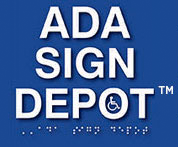How to Make a Disability-Friendly Home: 3 Key Spaces
ADA Sign Depot
November 17, 2016

{ Shop all our Handicapped Parking ADA Signs }
How to Make a Disability-Friendly Home, by Paul Denikin
by Paul Denikin
Copyright © 2016 DadKnowsDIY.com
All Rights Reserved
Paul Denikin is the author of the blog site Dad Knows DIY. Paul’s Do It Yourself journey started with the birth of Maggie, his second child, who has special needs. Contact Paul here
Many large-scale home improvements for accessibility can be very costly. Installing a ramp or a stair lift alone can be enough to break the bank. However, there are smaller projects that can be done without spending much money at all while improving the accessibility of your home. Making a home disability-friendly involves much more than simply constructing a wheelchair-access ramp. Here are some of the key areas in your home that you should be addressing for better accessibility.
The Bathroom is First
The typical hard surfaces used in bathrooms make them one of the most dangerous rooms in the house for a person with a disability. Regardless of age, a fall in the bathroom can be very serious. For someone with fatigue, standing at the sink, in front of the mirror, or in the shower can be extraordinarily taxing.
To make your bathroom more disability-friendly, you have a few different options. A lightweight, plastic shower chair is a great way to improve a disabled person’s ability to use your shower. A handrail alongside the toilet makes it easier to sit and rise from the seat. If you have rugs, make sure they are either tacked down or have a no-slip material beneath them. Thin rugs are preferable as thick rugs can cause tripping. Depending on your bathroom, you may be able to make more minor modifications.
Kitchens Can Be Tricky
The average kitchen is intended to be used while standing. For someone without a disability, the prospect of standing and walking around the kitchen for a few hours while cooking is easy to contemplate. For someone who is disabled, standing and walking for that long can be impossible.
If possible, lower a section of your counter to be used while seated. A short table in the area can also do the trick. Install a hose in your sink so that it is easily used by someone at the lower level. Lazy susans in deep cupboards and even your refrigerator can make items in the back easier to reach.
It is also a good idea to rearrange your home with disabilities in mind. Place heavy and frequently used items in lower areas and use taller storage for less commonly used items. You would be surprised by how helpful it is to simply reorganize a few commonly used areas in the home.
Don’t Forget the Walkways
For people with vision or mobility impairments, a cluttered or dim walkway can be difficult to navigate. Simply clearing the main walkways through your home can be a huge improvement. You can also take the time to swap your light bulbs out for something brighter as well as placing new lighting fixtures in dimmer areas.
A well-lit, decluttered path throughout the home is more valuable than you may realize. You should also check for unsecured rugs. Even outside the bathroom, rugs can pose a risk to people with disabilities.
Making your home more accessible to those with disabilities does not have to be as difficult and expensive as you may think. It can even be as simple as decluttering and reorganizing. Of course, adding a few extra amenities can’t hurt.
Image via Pixabay by Monoar
- Tags: ADA People Subscribe to this blog's RSS feed.


